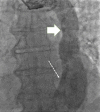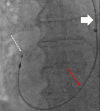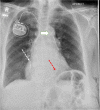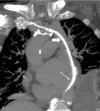Pacemaker Implantation in Patient With Persistent Left Superior Vena Cava and Absent Right Superior Vena Cava
- PMID: 32523837
- PMCID: PMC7273469
- DOI: 10.7759/cureus.7980
Pacemaker Implantation in Patient With Persistent Left Superior Vena Cava and Absent Right Superior Vena Cava
Abstract
Persistent left superior vena cava (LSVC) is an asymptomatic congenital heart disease. It is usually found incidentally on imaging, during central line placements or while undergoing electrophysiological procedures. We present a case of a 91-year-old female who initially presented with seizures and was diagnosed with tachy-brady syndrome. She was planned to undergo dual-chamber permanent pacemaker placement. However, during the procedure, she was incidentally found to have an LSVC without a right superior vena cava. Due to challenging anatomy, her pacemaker was changed to a single-chamber atrial lead pacemaker. This case highlights the clinical implications of this unusual structural anomaly, technical difficulties that arise alongside and solutions on how to overcome these issues in the context of pacemaker implantation.
Keywords: absent right superior vena cava; pacemaker; persistent left superior vena cava.
Copyright © 2020, Sabzwari et al.
Conflict of interest statement
The authors have declared that no competing interests exist.
Figures




References
-
- Absent right superior vena cava. Kumar SSNR, Dhulipala S, Subhrahmanyam AH, Pisharath MKS. Indian J Thorac Cardiovasc Surg. 2005;21:34.
-
- Persistent left superior vena cava: incidence, significance and clinical correlates. Tak T, Crouch E, Drake GB. Int J Cardiol. 2002;82:91–93. - PubMed
Publication types
LinkOut - more resources
Full Text Sources
